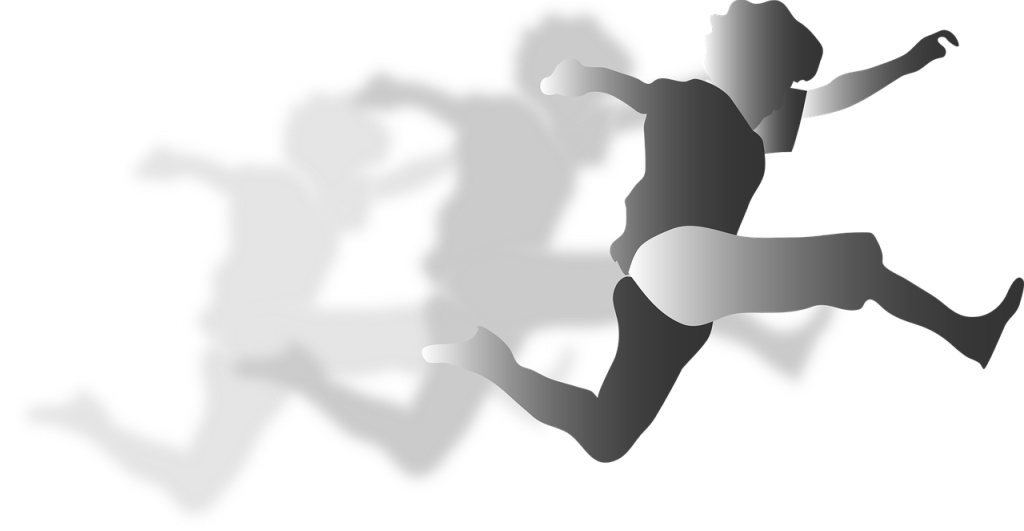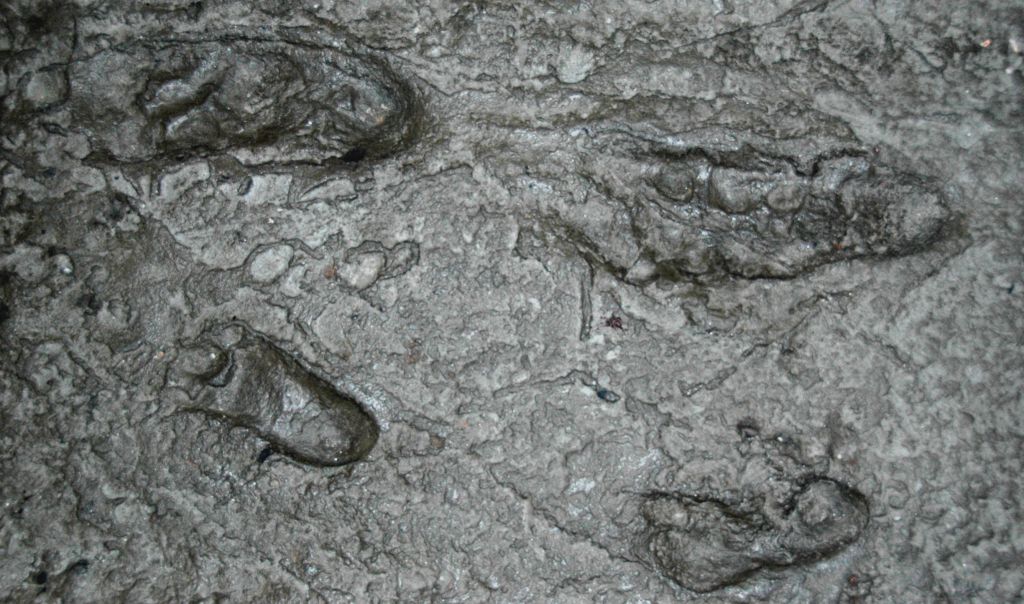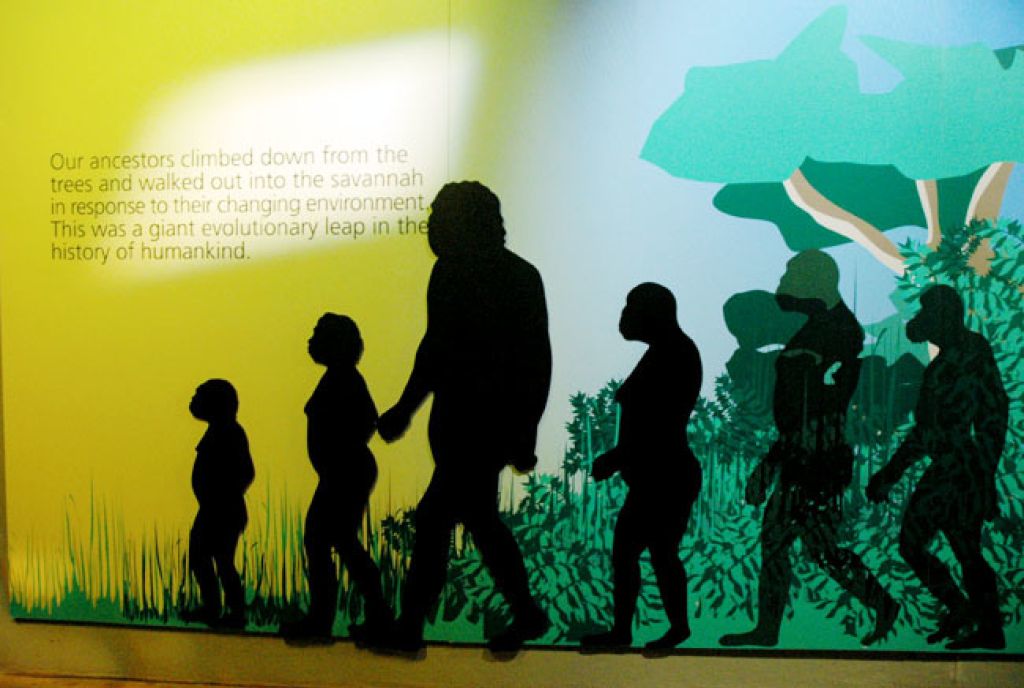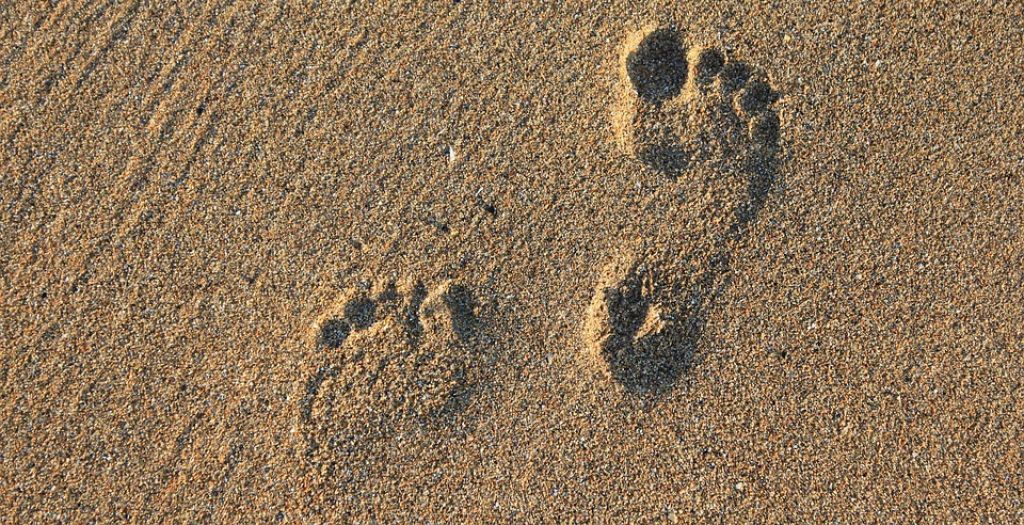Bipedalism (the ability to walk on two legs)

The ability to walk upright on two legs is one of humanity’s defining physical characteristics.
Bone structure
Our bones are organised to help us walk on two legs. The pelvis, leg bones (femurs), knee joints and foot bones of early hominids give palaeoanthropologists good indications as to the way they moved around.
Palaeoanthropologists can also tell whether hominids walked upright from their skulls by looking at the foramen magnum – the point the spine enters the skull – and thus the natural position of the head.
Preserved footprints
At Laetoli in Tanzania, just south of Olduvai Gorge, a set of Australopithecus afarensis footprints of two individuals walking along side by side, has been dated to 3.5-million years ago.
The preservation of the footprints was due to a remarkable set of circumstances. Initially, a nearby volcano called Sadiman erupted, blowing a cloud of fine ash that settled over the surrounding areas. Then rain fell, creating something similar to wet cement.

Many birds and animals walked over this wet “cement”, leaving their footprints in it. Among them, walked two Australopithecus afarensis hominids, a large one and a small one, side by side. The larger one was probably carrying something heavy, since it left a deeper indentation on one side. Perhaps it was a mother carrying a child.
Then Sadiman erupted again, leaving yet another layer of ash and sealing the footprints for the future. Erosion over millions of years eventually exposed the footprints, which were found by researchers working with Mary Leakey. They were excavated in 1978.
The footprints are not fully human and have ape-like features including a slightly divergent big toe. Researchers assume they were made by Australopithecus afarensis because they are the only hominids represented in the fossil record in East Africa for that period.
Fossilised footprints from more than 3-million years ago tell us that our ancestors walked upright, much like us.
How did bipedalism begin?
There are various theories about when our ancestors started walking upright, but a popular view is that perhaps about 7-million years ago, early hominids began to adapt to a climate that was cooling globally.
The huge rainforest expanses in Africa were being replaced with savannah and patches of woodland, requiring the tree-climbing apes to become more adept at walking on land.
Our ancestors who ventured out into the savannah were rewarded with roots, shrubs and occasional animal carcasses, ensuring that those who walked on two legs were more likely to survive.
The jump from trees to land wasn’t as big as some might see it. Some of the early hominids’ anatomical structures may have already been pre-adapted to bipedalism while climbing trees and stretching for fruit.
The advantages
The host of advantages bipedalism brought meant that all future hominid species would carry this trait.
Bipedalism allowed hominids to free their arms completely, enabling them to make and use tools efficiently, stretch for fruit in trees and use their hands for social display and communication. They could also see further over the savannah grass – but this also could have been a disadvantage since predators could probably spot them more easily.
Bipedal hominids could spend more time foraging and scavenging out in the open savannah because their bodies would be exposed to less sunlight standing upright.

Walking on two limbs was also more energy efficient than walking on four – giving early hominids more energy to reproduce and therefore more chance of producing offspring bearing this unique trait.
But even with these advantages, these transitional hominids probably spent time in the trees as well.
At least some Australopithecus species, including the one represented by “Little Foot” at Sterkfontein, which is as yet unnamed, were at least partly arboreal between 4-million and 3-million years ago, when there was some forest in the Cradle of Humankind environment.
Similarly, further north in Africa, the Australopithecus species of Ethiopia and Tanzania between 3-million and 2-million years ago would have been able to climb trees better than modern humans, but were simultaneously adapting to more full-time upright walking.
Australopithecus afarensis, which populated the Afar Depression in Ethiopia, would have lived in an environment typified by wetlands, woodland and forest. But the bipedal footprints of Australopithecus afarensis in Laetoli, Tanzania, are found in an area where the environment was probably drier and sparsely wooded 3.6-million years ago.
“Little Foot”, which represents a species of Australopithecus more than 3.3-million years old, was most certainly not a knuckle-walker like some of the great apes. It probably could have walked and climbed effectively.
“Little Foot” and other early australopithecines probably climbed trees to escape predators and maybe even to sleep in at night.
Did you know?
Many dinosaurs were bipedal!
How our joints help us to walk

Ball-and-socket joint
The ball-and-socket joint is the most mobile type of joint, allowing us to swing our arms and legs in many different directions. The joint is made up of a ball-shaped bone which rotates in a cup-shaped cavity, as in our hips and shoulders.
Hinge joint
Hinge joints, such as the knee and elbow, act as a lever that enables our arms and legs to flex (bend) and straighten. The movement is similar to the opening and closing of a hinged door.
Pivot joint
In a pivot joint, one bone twists against another. Pivot joints are found between the upper bones of the neck, allowing you to turn your head from side to side.
Semi-movable joint
Semi-movable joints, such as those found in the spine, only allow partial movement. The joints are connected by pads of cartilage that restrict movement.
Return to the Exhibition Guide.